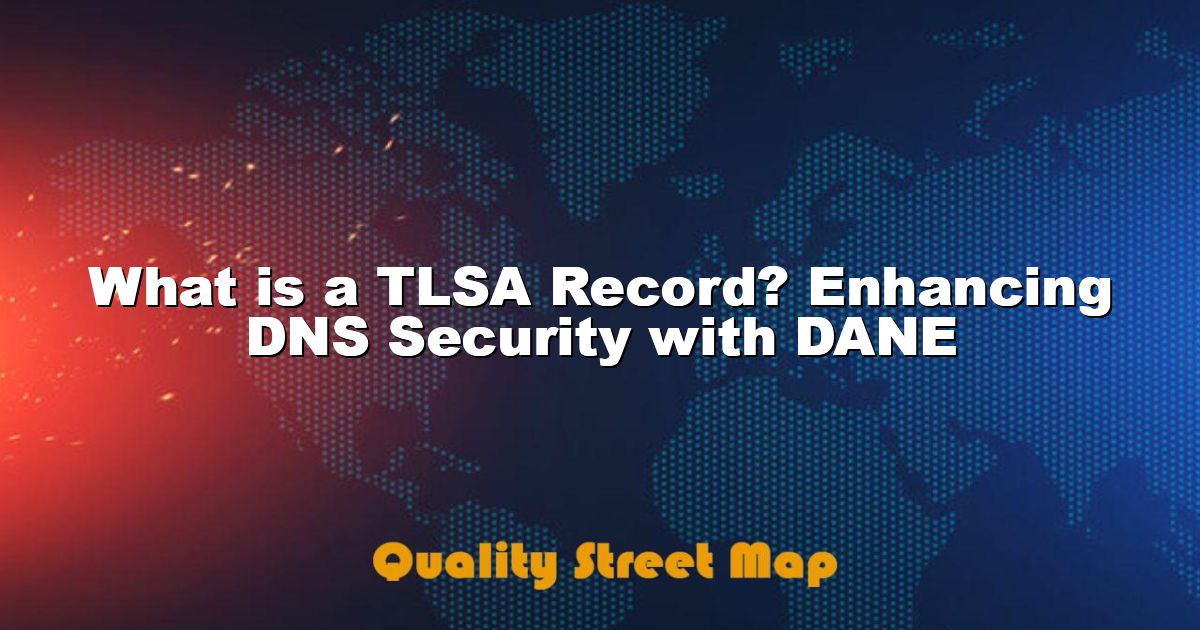What is a TLSA Record? Enhancing DNS Security with DANE

What Is A TLSA Record?
A TLSA record is a specific type of Domain Name System (DNS) record used to associate certificates or public keys with domain names, enhancing security protocols within the DNS infrastructure. Its primary function is to establish a chain of trust, ensuring that communication between a client and server remains secure. By working in tandem with DNS-based Authentication of Named Entities (DANE), TLSA records provide an additional layer of security, enabling domains to define their authentication mechanisms and preventing potential man-in-the-middle attacks. When asking what is a TLSA record, it’s crucial to understand its role in strengthening DNS security through certificate validation.
Understanding The Basics Of TLSA Records
- TLSA records map domain names to the X.509 certificate used to secure the server.
- They are primarily used in conjunction with DNSSEC to verify domain authenticity.
- TLSA stands for TLS Authentication, indicating its role in Transport Layer Security (TLS).
- These records can specify the required Certificate Authority (CA) for a domain’s certificate.
- TLSA records help define constraints on the key usage and matching algorithm.
- They offer flexibility in certificate management by allowing end-entity certificates or trust anchors.
- TLSA records reduce reliance on traditional CA systems, increasing security independence.
TLSA records serve a critical purpose in domain-based security by aligning certificate constraints with DNS security extensions. When asking what is the role of these records, the emphasis is on providing encrypted data exchanges. By handling certificate verification directly, TLSA reduces dependencies on third-party certificate authorities, crafting a more secure web environment. Notably, TLSA records are specified through the _dane. domain-prefixed mechanism, making them easy to identify within a DNS setup.
Implementing DNSSEC-compliant TLSA records enables seamless integration of authentication protocols, crucial for ensuring secure connections. The TLSA parameters, such as Usage, Selector, and Matching Type, are configured to specify how a TLSA record should be interpreted. The significance of a TLSA record can be summarized with the intent to enable a domain to assert which certificate or public key should be trusted for its services. As highlighted, with TLSA records, domains can effectively reduce cyber threats by verifying their own certificate identities, reinforcing the principle of robust digital security practices.
Integrating TLSA Records Into DNSSEC: A Step-By-Step Guide
Incorporating TLSA records into DNSSEC provides an additional layer of security for DNS data. To understand what is a TLSA record’s role in enhancing DNS security, it’s essential to look at the process of implementing it within an existing DNSSEC framework. TLSA records, part of the DANE protocol, enable the binding of domain names to TLS certificates, ensuring authenticity and protecting against potential threats like man-in-the-middle attacks. This integration can effectively protect users from encountering malicious sites posing as legitimate ones.
Steps For Integrating TLSA Records With DNSSEC
- Ensure your DNS is already secured with DNSSEC before proceeding with TLSA integration.
- Obtain a valid and up-to-date TLS certificate for the services you intend to protect.
- Generate a TLSA record using the hash of the TLS certificate’s public key.
- Publish the TLSA record in the DNS zone file, ensuring it’s correctly formatted and aligns with your DNS structure.
- Validate the TLSA record using DNSSEC to ensure it’s properly synchronized and secure.
- Regularly monitor the records to maintain validity with any certificate updates.
- Test the configuration to verify that the TLSA records are functioning as expected in enhancing DNS security.
Understanding how TLSA records function within the DNSSEC system requires recognizing their unique benefits. The support offered by TLSA mechanisms results in a more robust defense structure, allowing for greater assurance in communication security. Encrypting the pathways ensures users are connecting with verified and trusted websites, significantly reducing the risk of fraud.
How TLSA Enhances Security
A primary advantage of using TLSA records is their ability to provide cryptographic bindings between domain names and their respective TLS certificates. By implementing this, administrators can prevent unauthorized certificate replacements and ensure that users are securely connected to the intended server. This binding power is critical for countering threats, particularly from rogue CAs issuing fraudulent certificates.
Practical Implementation Examples
Businesses with complex web architectures can benefit significantly from TLSA record integration. For instance, banking institutions employ TLSA records to bolster the security of their online platforms, protecting customer data from intercepts. Similarly, e-commerce sites use these records to guarantee safe transactions, by ensuring customers connect to legitimate servers. Such implementations underscore the practical impact TLSA records have in real-world applications, showcasing their indispensable role in fostering secure digital environments.
Concluding DANE And DNSSEC With TLSA Records
When evaluating the implementation of DANE with DNSSEC through TLSA records, it becomes clear that these records serve a pivotal role in reinforcing internet security protocols. But what is the ultimate benefit of incorporating TLSA records into your security strategy? By binding TLSA records with DNSSEC, users can ensure that the authenticity of SSL/TLS certificates is verifiable via DNS. This process eliminates the risks associated with fraudulent digital certificates and enhances trust in online communications and transactions.
As the digital landscape continues to evolve, the responsibility of safeguarding data communication channels has never been greater. TLSA records stand as a testament to this advancement in cybersecurity.
In order to implement a robust DNS security framework, it’s essential to understand the strategic placement of TLSA records within the DNS architecture. This requires a detailed configuration and verification process to guarantee effective protection against cyber threats. When executed correctly, it results in a comprehensive shield against potential vulnerabilities in SSL/TLS validations.
Actionable Takeaways For Effective DNS Security
- Understand the role of TLSA records in the DNS infrastructure.
- Ensure accurate configuration of TLSA records for optimal security.
- Regularly update and verify your SSL/TLS certificates through DNSSEC.
- Monitor DNS traffic to identify and mitigate potential security breaches.
- Adopt a layered security approach to synergize TLSA and DNSSEC.
- Engage experts for regular security audits and assessments.
- Stay informed about the latest updates and best practices in TLSA record management.
Implementing TLSA records effectively is not just a task, but a transformative upgrade for internet security protocols. Their capability to act as a trust anchor within DNSSEC is paramount for establishing secure and verified communications. By streamlining SSL certificate validation, these records reduce reliance on external certificate authorities, thus offering an additional layer of security. Transitioning to DNSSEC with accurately configured TLSA records should be a priority for any organization aiming to bolster its cybersecurity measures.
Finally, although setting up and maintaining TLSA records requires technical expertise and constant vigilance, the benefits significantly outweigh the efforts involved. Organizations that commit to integrating TLSA records with their DNSSEC protection strategies can expect a more secure and reliable digital presence. This not only ensures data integrity but also bolsters user confidence in the safety of their online interactions. As we conclude on the advantages of DANE enhanced with TLSA records, it’s clear that the future of internet security should embrace these advancements for stronger, more reliable networks.















